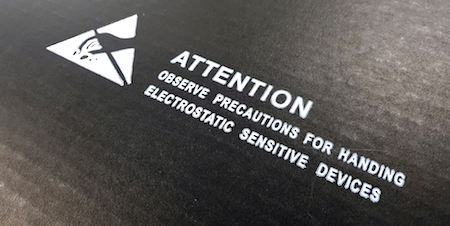Electrostatic Discharge (ESD) . is a very common, yet often overlooked problem that can plague electronic equipments in a mysterious way. ESD is like an invisible, mischievous gremlin that come and go un-noticed, until the related failures or malfunctions become apparent. Yet, ESD by its elusive but superfast characteristics and very high frequency spectrum definitely belong to the EMI family. Once understood, the solutions to it are not very different than those for the more classical interference problems, bearing in mind that we will be dealing with a frequency domain up to the GHz, where some EMI solutions are simply not appropriate.
.
1. The origins of the problem, a brief overview
Normally, for any material, conductive or not, the number of (-) charges (electrons) in each atom is exactly balanced by an equal number of (+) charges (protons), such as the net electrical charge seen from outside is null. If the material is an insulator, electrons do not move freely when subjected to an electric field, so if the materiel surface is being rubbed, or subject to sufficent friction with another material, with air or a non-conducting fluid, the peripheral orbits of the atoms will either loose, or capture some electrons. The result is a charge unbalance: the material may have lost a certain number of (-) charges, becoming positively charged, or acquired some extra electrons, becoming negatively charged.
The process by which components, tools, objects, people, vehicles, aircrafts, rockets, even clouds or water can become charged is extremely complex and multifacet. It would take at least an entire book for a decent coverage of the subject. Readers who are interested could consider some of the references given at the end. Following are some simple examples of E.S charging process: people shuffling their shoes on carpet or synthetic floor, clothes or underware rubbed against seats fabric, rapid flow of liquid, fuel, thin grains or even distilled water through isolated tubes, friction of rubber belts against ungrounded pulleys etc. Thousands of such episodes are causing ES charging that may end-up in more or less severe ESD events, if not dissipated properly.
An ESD happens when these static charges have built-up up to a point where the potential difference – say the excess of (+) charges, and / or the deficit of (-) charges ) is such as the insulation barrier – most often but not always air, is ruptured causing an abrupt recombination, usually with an arc.
Examples of Electrostatic charging scenarios: ESD is causing not only a discharge current, but also an intense electromagnetic fields over a broad frequency range, from (dc) to the low GHz, plus corona effects before and during a discharge. The ”culprit”, or intruder, is often a human, but it may be any object that is moved, such as a chair, an equipment cart, a vacuum cleaner. The victim is usually an electronic equipment or subassembly and is, although not always, at local static ground potential. It may occur that the equipment is ”victim of itself ”, whether…
Dear colleague,
This text is unfortunately locked for further reading, but you can read all Michel Mardiguian’s texts and course material about EMC in the new book ”Everything you always wanted to know about EMC but were afraid to ask”. Click for more information!


